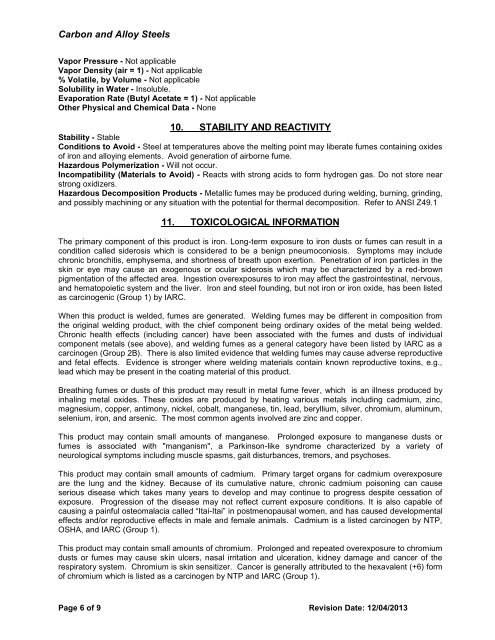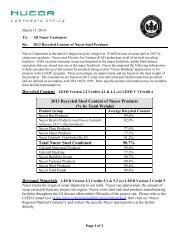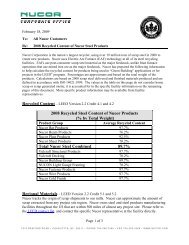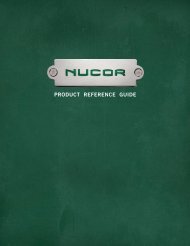Building Systems - Nucor
Building Systems - Nucor
Building Systems - Nucor
You also want an ePaper? Increase the reach of your titles
YUMPU automatically turns print PDFs into web optimized ePapers that Google loves.
Carbon and Alloy Steels<br />
Vapor Pressure - Not applicable<br />
Vapor Density (air = 1) - Not applicable<br />
% Volatile, by Volume - Not applicable<br />
Solubility in Water - Insoluble.<br />
Evaporation Rate (Butyl Acetate = 1) - Not applicable<br />
Other Physical and Chemical Data - None<br />
10. STABILITY AND REACTIVITY<br />
Stability - Stable<br />
Conditions to Avoid - Steel at temperatures above the melting point may liberate fumes containing oxides<br />
of iron and alloying elements. Avoid generation of airborne fume.<br />
Hazardous Polymerization - Will not occur.<br />
Incompatibility (Materials to Avoid) - Reacts with strong acids to form hydrogen gas. Do not store near<br />
strong oxidizers.<br />
Hazardous Decomposition Products - Metallic fumes may be produced during welding, burning, grinding,<br />
and possibly machining or any situation with the potential for thermal decomposition. Refer to ANSI Z49.1<br />
11. TOXICOLOGICAL INFORMATION<br />
The primary component of this product is iron. Long-term exposure to iron dusts or fumes can result in a<br />
condition called siderosis which is considered to be a benign pneumoconiosis. Symptoms may include<br />
chronic bronchitis, emphysema, and shortness of breath upon exertion. Penetration of iron particles in the<br />
skin or eye may cause an exogenous or ocular siderosis which may be characterized by a red-brown<br />
pigmentation of the affected area. Ingestion overexposures to iron may affect the gastrointestinal, nervous,<br />
and hematopoietic system and the liver. Iron and steel founding, but not iron or iron oxide, has been listed<br />
as carcinogenic (Group 1) by IARC.<br />
When this product is welded, fumes are generated. Welding fumes may be different in composition from<br />
the original welding product, with the chief component being ordinary oxides of the metal being welded.<br />
Chronic health effects (including cancer) have been associated with the fumes and dusts of individual<br />
component metals (see above), and welding fumes as a general category have been listed by IARC as a<br />
carcinogen (Group 2B). There is also limited evidence that welding fumes may cause adverse reproductive<br />
and fetal effects. Evidence is stronger where welding materials contain known reproductive toxins, e.g.,<br />
lead which may be present in the coating material of this product.<br />
Breathing fumes or dusts of this product may result in metal fume fever, which is an illness produced by<br />
inhaling metal oxides. These oxides are produced by heating various metals including cadmium, zinc,<br />
magnesium, copper, antimony, nickel, cobalt, manganese, tin, lead, beryllium, silver, chromium, aluminum,<br />
selenium, iron, and arsenic. The most common agents involved are zinc and copper.<br />
This product may contain small amounts of manganese. Prolonged exposure to manganese dusts or<br />
fumes is associated with "manganism", a Parkinson-like syndrome characterized by a variety of<br />
neurological symptoms including muscle spasms, gait disturbances, tremors, and psychoses.<br />
This product may contain small amounts of cadmium. Primary target organs for cadmium overexposure<br />
are the lung and the kidney. Because of its cumulative nature, chronic cadmium poisoning can cause<br />
serious disease which takes many years to develop and may continue to progress despite cessation of<br />
exposure. Progression of the disease may not reflect current exposure conditions. It is also capable of<br />
causing a painful osteomalacia called “Itai-Itai” in postmenopausal women, and has caused developmental<br />
effects and/or reproductive effects in male and female animals. Cadmium is a listed carcinogen by NTP,<br />
OSHA, and IARC (Group 1).<br />
This product may contain small amounts of chromium. Prolonged and repeated overexposure to chromium<br />
dusts or fumes may cause skin ulcers, nasal irritation and ulceration, kidney damage and cancer of the<br />
respiratory system. Chromium is skin sensitizer. Cancer is generally attributed to the hexavalent (+6) form<br />
of chromium which is listed as a carcinogen by NTP and IARC (Group 1).<br />
Page 6 of 9 Revision Date: 12/04/2013








